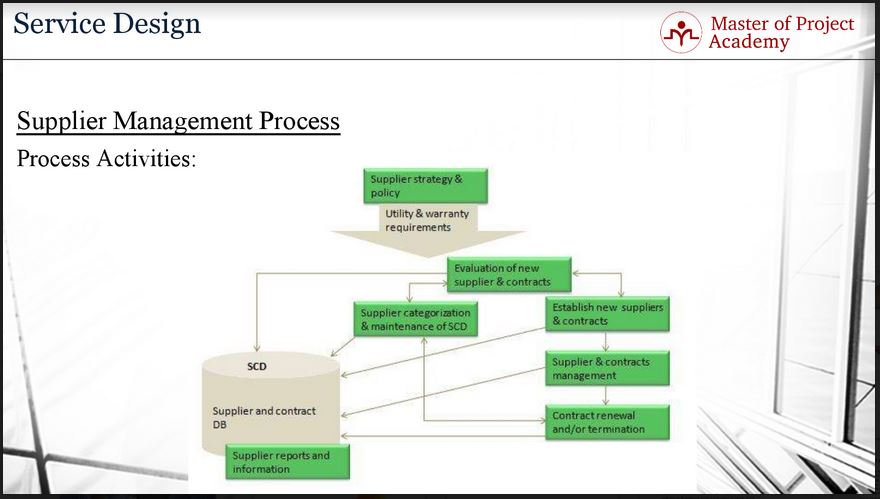Supplier management is an important part of the ITIL foundation certification training framework. Suppliers might be involved throughout the ITIL service lifecycle and supplier management must be applied from the Service Strategy stage right through to the Continual Service Improvement stage. Online ITIL courses describe the importance of supplier management in ITIL service management.
Based on the business of an organization or company, an IT service provider might need to use services of the partners or suppliers. For instance, in order to provide search functionality inside the corporate applications, Google provides enterprise services for the companies. And companies or organizations pay money for the provided services to these suppliers and partners. Supplier management is necessary to facilitate interactions between IT service providers and their suppliers. This article will describe the goals, objectives, and activities of supplier management.
What’s The Goal?
The main goal of the supplier management process is the management of supplier and their services to provide firstly, seamless quality of IT services to the business and secondly ensuring that value for money is obtained. Based on the service level agreements signed off between the business and the IT service provider, the IT service provider might need to use external services from partners or suppliers.
Let’s consider that the IT department of the organization aims to provide employee details to the human resources department of the company. And this service is provided with a search function where whenever a human resource department employee starts to type more than 3 characters in the search box, all matches in the database are listed as auto suggest mode. And let’s assume that this search and autosuggest functionality will be provided by a Google Search server that will be placed in the company network. In this case, during supplier management process, service level targets and the service fee must be negotiated between the IT Service provider and Google, which is the supplier in this case. For instance, the expected search result time, the terms and conditions of providing this service, and the price of the service need to be determined. These are all negotiated and handled in the scope of supplier management process.
The Objectives
Assuring Cooperation with the Service Level Management Process
The Supplier Management process closely works with service level management process because, in order to meet the service level targets towards the business or customer, external services provided by the suppliers must have to meet its targets as well. In this respect, the Supplier management process aligns the business needs of the customer through the underpinning contracts that is signed off between the supplier and the IT Service Provider. This also ensures that targets agreed in Service Level Requirements and Service Level Agreements are supported.
Note that the IT Service Provider signs off the Service Level Agreements with the business or customer. And in order to meet the service level targets agreed in the SLA, if the IT service provider uses external services of the suppliers, the service level targets that has to be met in the external service are documented in underpinning contracts. This is part of supplier management.
Supplier performance management
As a natural outcome of the negotiation and agreements with the supplier management of the relationships with the supplier and also the supplier performance is the objective of the supplier management process as well. Let’s consider our previous example. You agreed with Google that the search server of the Google will turn back results in less than one hundred milliseconds, the autosuggest function will work after typing the 3rd character etc. These are all service level targets for the service provided by Google and after the underpinning contract has been signed, the IT service provider will monitor the actual results and performance of Google during the contract period which is an objective of Supplier Management process.

Negotiating and agreeing with suppliers
And the last objective of Supplier Management Process is the negotiating and agreeing with suppliers through contracts, and management of these contracts through their lifecycle. After terms, conditions, and service level targets are negotiated in underpinning contracts, these contracts are managed throughout their lifecycle. Contracts are generally signed off for a period of time. And during the contract period, the obligations and performance of the supplier are monitored as an objective of the supplier Management process.
Supplier Management: Supplier and Contract Database
All contracts with the cooperated suppliers and partners are stored in Supplier and Contract Database of the organization. The Supplier and Contract Database contains details on suppliers in relation to contracts and products and/or services. Depending on the size of the organization and external services provided by the different suppliers and partners, underpinning contracts that have to be managed by an IT service provider can be too many. In order to store, coordinate and manage all underpinning contracts in a central place, underpinning contracts are stored and managed through the Supplier and Contract Database.
Links in the supplier and contract database
Information on the purchase and linked contract details should be part of the supplier and contract database. Consider the Google search partnership example. The IT service provider might get the search software from Google but the server that will be running the search software can be provided by a hardware vendor such as Oracle. In this case, underpinning contracts with Google and Oracle will be linked since the external search service will be depending both on the search software and the hardware that will run the software. These kinds of links and purchase information details are stored in supplier and contract database.
Its relationship with Change management
Supplier and Contract Database should form an integrated part of the Configuration Management System or Service Knowledge Management System in an IT service provider. Although the service level targets, terms, and conditions are negotiated and agreed with a supplier, further revisions or updates might be required to the contracts in the future. In the case of changes to the contracts, changes in the supplier and contract database are progressed via the Change Management process. Change Management process belongs to ITIL Service Transition stage of the ITIL Service Lifecycle. Change Management is also part of the supplier management process.
Supplier management process activities
This figure summarizes the process activities of the supplier management process. Supplier Strategy and Policy defines the limits and constraints for supplier management. For instance, if there are competitors in the market that can provide services to your organization as a supplier, and if the supplier strategy and policy of your organization does not accept to get external services from a competitor, you cannot agree with that supplier. Based on the fences drawn by the Supplier Strategy and Policy of the organization, the IT Service provider evaluates new suppliers and contracts.

Many criteria can be used to select a supplier during supplier management. Performance on previous projects references from big companies, and the price of the service etc. are all common examples of major criteria during supplier evaluation in organizations. After the evaluation, the optimum supplier is selected to acquire the service and a contract is signed off. This contract is stored and managed with the help of Supplier and Contract Database. During the contract period, the actual performance of the supplier is compared against service level targets agreed in the contract. Based on the monitoring, if the supplier meets its target and if the IT Service Provider is satisfied with the provided service, the contract is renewed. In opposite case, the contract is terminated. During contract management, supplier’s reports and information about the provided service is stored in supplier contract database as well.
Review by: Kristin Barnes

